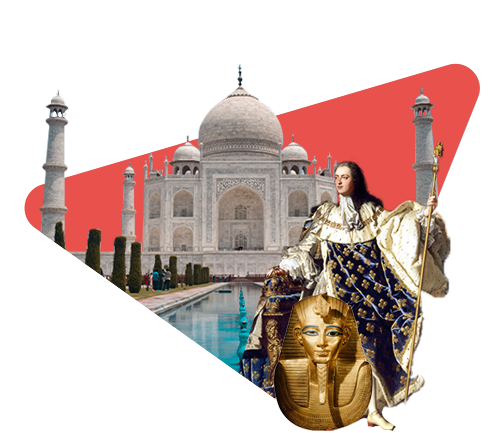Luxury is a notion that has developed and been redefined over time, reflecting historical trends and interpretations of wealth, taste, and technology. The earliest records of opulence and prestige are found in ancient civilizations of China, India, Egypt, Mesopotamia, Greece, and Rome, where the wealthiest residents indulged in lavish lifestyles covered in fine clothing and intricate jewelry, hosting epicurean feasts with gourmet food in their exclusive palaces; over-the-top celebrations were reserved for the highest echelons of the community.
Thousands of years ago in Greece and Rome, luxury was seen as a way to honor the gods, which is why sumptuous temples, bathhouses, gardens, and villas were built in their name, using exotic elements brought from the lands these Empires conquered—these places hold a significant cultural value and were the meeting grounds of statesmen and commanders, but are no longer considered standards of affluence. Nowadays, throwing a party of said magnitude would end up in a social-media frenzy because that concept of luxury no longer holds. Back then, living in a palace or castle was a guarantee of safety; the walls and moat were elements that protected royalty and their entourage.

Simultaneously, the empires of the East solidified their place in the world through commerce, trading spices, silk, and valuable stones from around the globe. The markets and bazaars became crossroads for banking, religion, and knowledge transfer, an international platform where tangible and intangible exchanges were prized. Those interactions led to recognizing the imbalances that the wealth and power gaps had created. The olden displays of wealth are now considered close to absurd; grandness in our residences is currently connected to high-end amenities and technological advances rather than gold-plated ceilings and walls full of jade-encrusted furniture.
As industrialization swept the world in the nineteenth and twentieth centuries, luxury grew to be more democratized, with the creation of modern retail and businesses that allowed for social mobility and the creation of new richness. Department stores welcomed the new middle class who had the goal of owning a home, the latest car, and the first modern appliances to elevate their status. People started to live closer and more organized; communities were built not as a result of closer bonds between neighbors, uniting like-minded individuals under the same district, suburb, or building, fostering more intimate relationships that would eventually define the spirit of a particular location (i.e. some neighborhoods specialized in trade or welcomed devotees of specific religions).
The 20th century saw the rise of consumer culture and globalization, with luxury goods becoming accessible to a wider range of people; the internet allowed us to buy things and reserve experiences with just a click. In turn, this technological growth gave rise to wellness experiences that allowed people to cultivate their well-being—being interconnected gave us the freedom of moving and creating new spaces for work and entertainment, ushering in a new era of digital wealth.
In recent years, the definition of luxury has continued to evolve, with a growing focus on experiences and sustainable, eco-conscious living. From high-end hotels and resorts to bespoke travel and wellness experiences, the modern definition of luxury is about creating meaningful, memorable experiences that are personalized and sustainable. The global wellness tourism industry is projected to reach $919 billion by 2023, reflecting a growing demand for sustainable, personalized experiences—most of which are becoming more available in condominium associations.
Perhaps most important are the connections between people from similar backgrounds; the appeal of living in a high-end association goes beyond great amenities—it’s an opportunity of being part of a social group that has similar interests and purchasing power. This in turn leads to the solidification of their pillars, resulting in the formation of posses that can range from tennis buddies to shared pool parties to carpooling and giving your neighbor’s kids a ride to school. This interconnectedness is increasingly noticeable in condominiums and homeowner associations that have taken inspiration from the hospitality industry, delivering comfort, personalized services, and exclusive experiences at the level of a five-star hotel.
Today’s picture is ever-expanding: the global luxury goods market is estimated to reach $1.5 trillion by 2025, setting a growing emphasis on comfort and eco-conscious living, with personalized technology at the forefront of quality of life. From smart homes, advanced wearable technology, immersive virtual experiences, and personalized platforms such as ONR, the future of luxury will be tailored to every individual, putting efficiency and performance at everyone’s fingertips.
The future communities will be more connected than ever through physical and digital platforms, providing tailored solutions and personalized attention—whether you’re physically in the space or not. Luxury is now synonymous with digitalization, a process that makes it easier to stay in touch with neighbors and management: simply, securely, and from anywhere on the planet. In order for services to constantly improve, it’s imperative for Management Companies, Property Managers and Community Leaders to be able to keep a tab on residents’ requests, a log of all interactions, and have a way to visualize, measure, and improve the quality of services.
At ONR, we’re devoted to helping Luxury Communities take the next step by offering the best all-in-one community management platform, incorporating: mass communications, voting and participation, common area reservations, a beautifully designed community portal (custom-built for each property), accounting integrations with the major players in the financial space, visitor management, mailroom logistics, and much more. ONR provides luxury management companies with the best tool for the job while delivering Residents the delightful living experience they demand.


